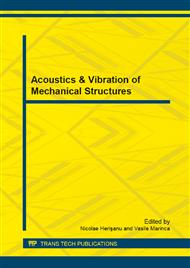p.70
p.78
p.84
p.90
p.95
p.101
p.108
p.113
p.118
Assessment of Corrosion Damages with Important Loss of Mass and Influences on the Natural Frequencies of Bending Vibration Modes
Abstract:
Corrosion as material destruction affects the safety of structures, leading to more serious consequences than the simple loss of a mass. The effect of corrosion on the dynamic behaviour of structures act in two ways: the loss of mass increases the natural frequencies, opposite to the effect of stiffness loss. This paper present the results of researches made to extend the mathematical relation presenting the influence of damage location and severity on the natural frequency changes, by adding the effect mass loss. Therefore we modeled the beam once with the discontinuity and loss of mass, afterwards the damaged segment is replaced by an intact one but having the mass similar to that of the damaged segment. This permitted to plot frequency shift curves for both cases and to contrive the relations defining that curves. Finally a relation summarizing the both effects was contrived; it was confirmed both by numerical simulations and experiments.
Info:
Periodical:
Pages:
95-100
Citation:
Online since:
September 2013
Keywords:
Price:
Сopyright:
© 2013 Trans Tech Publications Ltd. All Rights Reserved
Share:
Citation:


